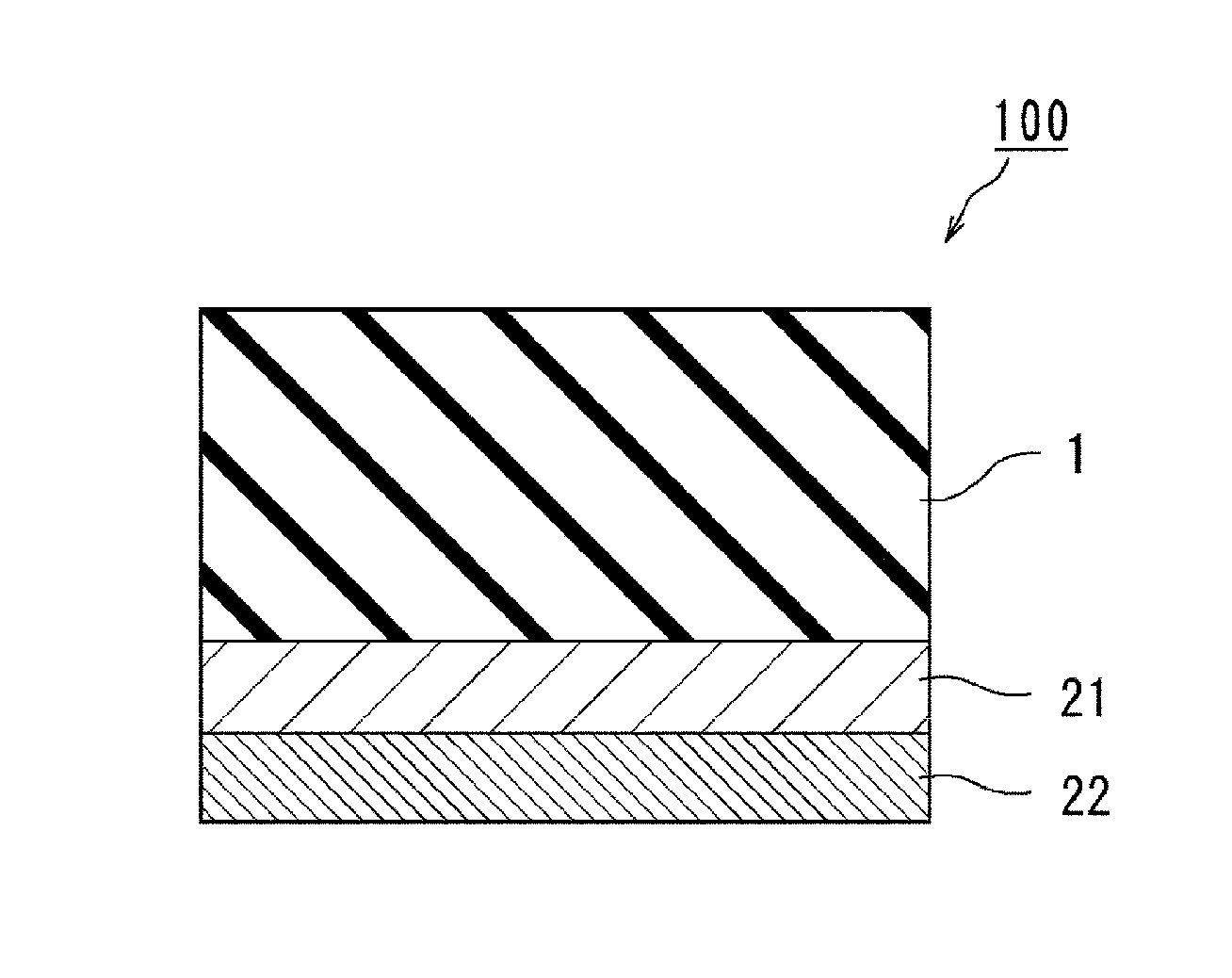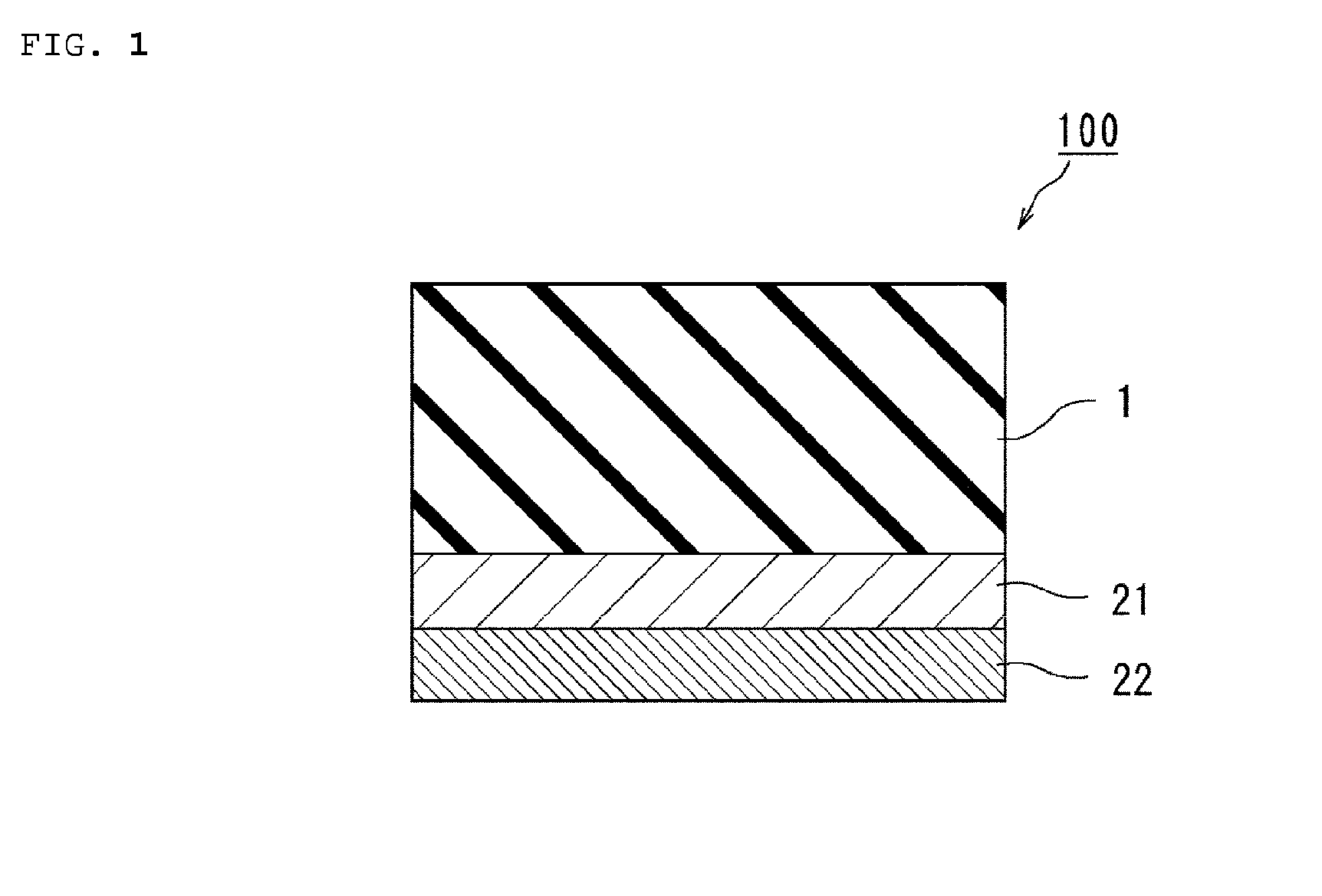Adhesive sheet
a technology of adhesive sheets and adhesive sheets, applied in the direction of film/foil adhesives, synthetic resin layered products, transportation and packaging, etc., can solve the problems of low environmental load, inability to perform pre-treatment of backing sheets, and inability to dry, so as to achieve high interlayer adhesiveness and reduce production costs. , the effect of high interlayer adhesiveness
- Summary
- Abstract
- Description
- Claims
- Application Information
AI Technical Summary
Benefits of technology
Problems solved by technology
Method used
Image
Examples
production example 1
[0170]The inside of a reaction vessel having a volume of 2 L and provided with a nitrogen-introducing tube, a temperature gauge, and a stirring machine was replaced with a nitrogen gas, and then 800 mL of toluene, 2.5 mL of N,N,N′,N″,N″-pentamethyldiethylenetriamine, 34 mL of a 0.6-mol / L solution of isobutyl bis(2,6-di-t-butyl-4-methylphenoxy)aluminum in toluene, and 3.5 mL of a 1.3-mol / L solution of sec-butyllithium in toluene were loaded into the vessel. 27 Milliliters of methyl methacrylate (MMA) were added to the mixture and then the whole was subjected to a reaction at room temperature for 3 hours. Next, the reaction liquid was cooled to −15° C. and then 160 mL of n-butyl acrylate (BA) were dropped to the reaction liquid over 7 hours. Subsequently, 27 mL of MMA were added to the reaction liquid and then its temperature was returned to room temperature, followed by stirring for 10 hours. The reaction liquid was poured into a large amount of methanol and then the deposited precip...
production example 2
[0171]The inside of a reaction vessel having a volume of 2 L and provided with a nitrogen-introducing tube, a temperature gauge, and a stirring machine was replaced with a nitrogen gas, and then 800 mL of toluene, 2.5 mL of N, N,N,N″,N″-pentamethyldiethylenetriamine, 34 mL of a 0.6-mol / L solution of isobutyl bis(2,6-di-t-butyl-4-methylphenoxy)aluminum in toluene, and 3.5 mL of a 1.3-mol / L solution of sec-butyllithium in toluene were loaded into the vessel. 27 Milliliters of MMA were added to the mixture and then the whole was subjected to a reaction at room temperature for 3 hours. Next, the reaction liquid was cooled to −15° C. and then 225 mL of 2-ethylhexyl acrylate (2EHA) were dropped to the reaction liquid over 7 hours. Subsequently, 27 mL of MMA were added to the reaction liquid and then its temperature was returned to room temperature, followed by stirring for 10 hours. The reaction liquid was poured into a large amount of methanol and then the deposited precipitate was recov...
example 1
[0172]A low-density polyethylene (LDPE) (manufactured by TOSOH CORPORATION, trade name: “Petrocene 190”) as a backing layer formation material, an α-olefin-based pressure-sensitive adhesive (AO) (manufactured by Sumitomo Chemical Company, Limited, trade name: “Tafthren H5002”) as a first pressure-sensitive adhesive layer formation material, and an acrylic block copolymer (manufactured by KURARAY CO., LTD., trade name: “KURARITY LA2140e,” Mw=8.0×104) (hereinafter, the acrylic block copolymer is referred to as “Ac3”) as a second pressure-sensitive adhesive layer formation material were loaded into an extruder and then subjected to melt extrusion from a T-die to be formed into a sheet shape in which a backing layer (having a thickness of 50 μm), a first pressure-sensitive adhesive layer (having a thickness of 10 μm), and a second pressure-sensitive adhesive layer (having a thickness of 10 μm) overlapped one another. After that, the sheet was wound into a roll shape to provide a pressur...
PUM
| Property | Measurement | Unit |
|---|---|---|
| peel angle | aaaaa | aaaaa |
| tension speed | aaaaa | aaaaa |
| temperature | aaaaa | aaaaa |
Abstract
Description
Claims
Application Information
 Login to View More
Login to View More - R&D
- Intellectual Property
- Life Sciences
- Materials
- Tech Scout
- Unparalleled Data Quality
- Higher Quality Content
- 60% Fewer Hallucinations
Browse by: Latest US Patents, China's latest patents, Technical Efficacy Thesaurus, Application Domain, Technology Topic, Popular Technical Reports.
© 2025 PatSnap. All rights reserved.Legal|Privacy policy|Modern Slavery Act Transparency Statement|Sitemap|About US| Contact US: help@patsnap.com


